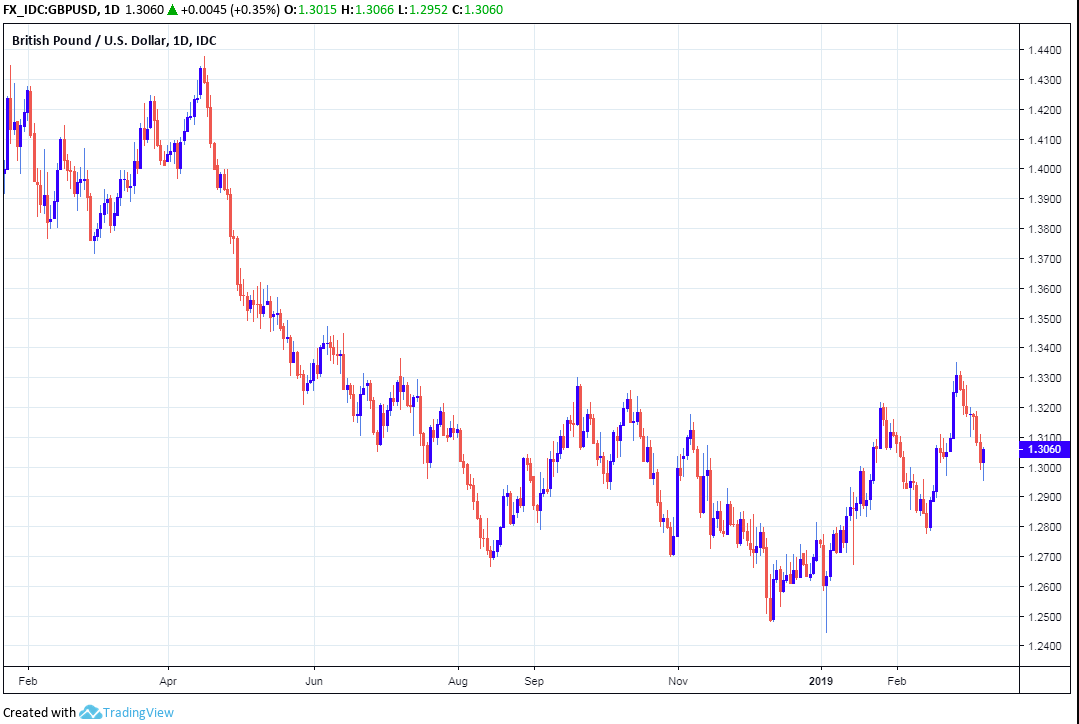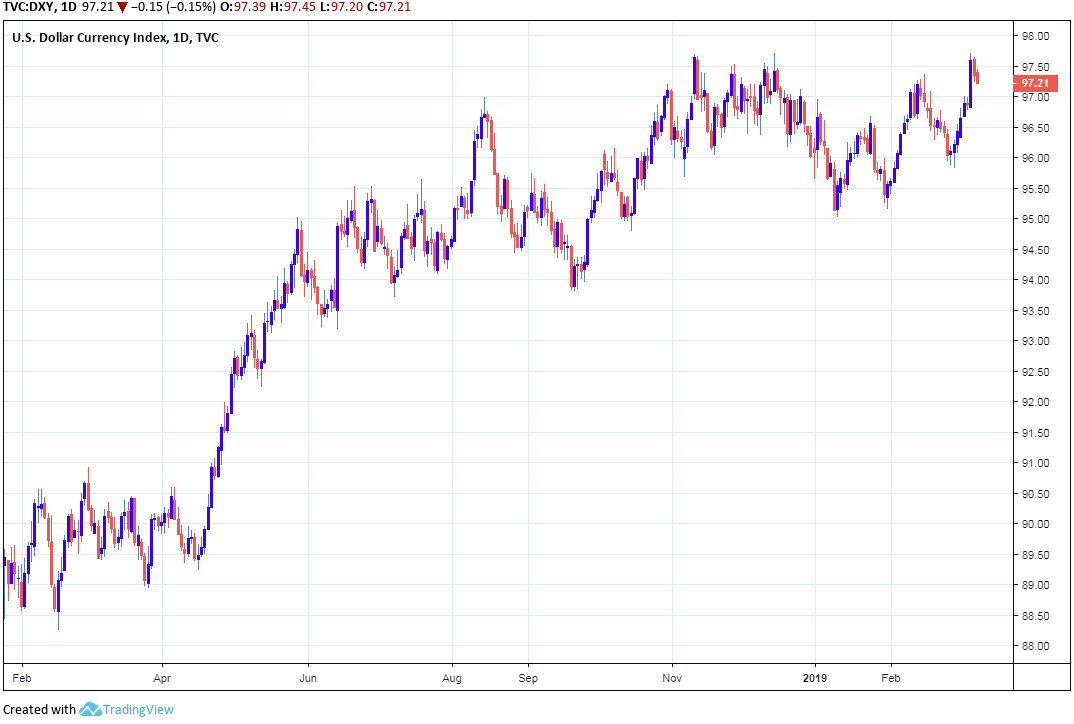Dollar Extends Losses after Retail Sales Data Confirms Economy Has Shifted into a Lower Gear
- Written by: James Skinner
-

© jcomp, Adobe Stock
- USD losses grow after retail sales figures not enough to dispel gloom.
- Retail, payrolls data confirm economy has shifted into a new, lower gear.
- Capital Economics says Fed hiking cycle over, others less downbeat.
The Dollar extended losses Monday after a retail sales figures for the month of February appeared to confirm the economy has shifted down a gear in recent months, strengthening some economists' convictions that the Federal Reserve (Fed) interest rate hiking cycle is now over.
Retail sales rose by 0.2% in February, which is better than the 0% growth anticipated by the market but not enough to make a dent in the downwardly-revised -1.6% fall seen back in December. Figures for January have not been and will not be released, due to the government shutdown of that month.
Core retail sales rose by 0.9% in February, which was far ahead of the consensus for growth of 0.4%, although again the upside surprise doesn't even come close to reversing the downwardly-revised -2.1% fall seen in December.
The core number excludes car sales because of their large purchase price and the distorting impact they have on underlying trends in sales. For that reason, markets tend to place more emphasis on the core number.
"While that appears to be a decent gain, it comes off of a downwardly-revised December print (now -2.3% vs. -1.7% prev.) which leaves the three-month annualized rate of sales in negative territory," says Katherine Judge, an economist at CIBC Capital Markets, of the core number.
The data matters for the greenback because of what it might mean for growth of the U.S. economy this year, which is important in light of the January monetary policy shift by the Federal Reserve.
Sales data provide insight into the likely pace of growth in a given period and momentum within an economy is an important determinant of inflation.
Changes in interest rates are normally only made in response to movements in inflation but impact currencies because of the push and pull influence they have over capital flows, and their allure for short-term speculators.
"The government shutdown in January means that there could be a further rebound in sales ahead as people returned to work and received paychecks again," Judge adds. "For now, it appears that consumer spending will only see modest growth in Q1, assuming a further rebound in the months ahead."
The U.S. government closed in January after a political dispute over funding of certain projects left federal agencies unable to pay staff, although the shutdown has had an impact on the collection of economic data too.
Retail sales fell by a show-stopping -1.2% in December, more than reversing a downwardly-revised 0.1% reading from November, when economists had looked for a 0.1% gain for the final month of the year.
The core retail sales number fell even further. So large were the declines, and so out of sync with other data covering different parts of the economy for the same period, economists were reluctant to take the numbers seriously.
However, the figures released Monday appear to suggest that at least some of the decline in December's sales was the result of weakness in the underlying economy, rather than just simply disrupted data collection.
"The robust core January numbers make sense, given that we didn’t believe the terrible-looking December numbers. But December sales have been revised *down* by a few tenths, and are now even further short of the strength evident in the Redbook chainstore sales survey," says Ian Shepherdson, chief U.S. economist at Pantheon Macroeconomics. "The official data are subject to endless further revisions, and we remain of the view that eventually they will be revised higher."

Above: Pound-to-Dollar rate shown at daily intervals.
The Pound-to-Dollar rate was quoted 0.25% higher at 1.3040 following the release after reversing an earlier fractional loss and is now up 2.4% for 2019, while the Euro-to-Dollar rate was 0.13% higher at 1.1244 but has fallen -1.8% this year.
The Dollar index was quoted -0.09% lower at 97.29, with the greenback's gains and losses spread out almost evenly across the G10 basket. The Dollar was lower against most G10 rivals following the release, after having traded higher against half of the basket ahead earlier in the session.

Above: Dollar Index shown at daily intervals.
"Control group retail sales growth is on course to remain unusually weak in the first quarter. Along with the weakness in vehicle sales, that suggests real consumption growth will slow further in the first quarter and supports our forecast that GDP growth is set to slow to below its 2% potential pace," says Andrew Hunter, an economist at Capital Economics. "Along with the weak February payrolls data released last week, this reinforces our view that the Fed will not raise interest rates at all this year."
Monday's data matters for the greenback because of what it might mean for growth of the U.S. economy this year, which is important in light of the January monetary policy shift by the Federal Reserve.
The Fed said in January it will be slower to raise rates this year because it wants time to observe future developments in the global economy, given a slowdown overseas could easily undermine U.S. growth and inflation prospects.
That shift came amid a clear and protracted slowing of the Chinese and Eurozone economies, which is thought to have been brought about in large part by President Donald Trump's trade war with China.
Retail sales numbers come just a day ahead of the latest inflation figures, which are expected to show consumer price pressures remaining elevated thus far in 2019, which could yet prove sufficient enough to entice the Fed off the sidelines sooner or later.
"We expect the dollar to remain bid against the low yielders this week and risk assets to reclaim some of their recent losses," says Chris Turner, head of FX strategy at ING Group. "Our team look for a bounce back in Retail Sales (January) and Industrial Production (February). This should question what’s currently priced into the US money market curve, where the market currently sees a 20bp decline in the Fed Funds rate by end 2020."
Monday's figures also follow a February nonfarm payrolls report that unsettled markets. The U.S. economy created just 20k new jobs last month, down from 311k in January, although the unemployment rate fell from 4% to 3.8%.
In short, many recent U.S. economic figures have pointed toward a slowdown in growth over the coming quarters, at a time when the Federal Reserve is growing cautious about the outlook and more reluctant to raise its interest rate.
"It is not just the Fed and the ECB that are now perceived as having moved to a more dovish position. We have dropped our forecast for a BoE rate hike this year. The market read this month’s BoC statement as less hawkish than expected and there is speculation that the RBA could potentially cut rates twice this year. Meanwhile, the BoJ is showing no sign of steering away from its huge QQE programme," says Jane Foley, a strategist at Rabobank. "Against this backdrop it is likely that interest rate differentials will continue to support the USD in the coming months."
The above trend is important for the Dollar because it was an exceptional economic performance last year that enabled the Fed to lift its interest rate four times even as other central banks were sidelined by slowing growth.
This policy divergence powered the greenback to a near-5% gain last year but if the economy has now turned a corner the greenback could be looking at a much less exciting few quarters ahead of it. And until markets know which is more likely, Dollar exchange rates could remain trapped within their recent ranges.
"Better US activity data this week, plus February core CPI continuing at 2.2% YoY should see US rates firm and probably send the heavily G7-weighted DXY through strong resistance in the 97.70 area. Our preference here is that USD/JPY can climb back to the 112.20 area," says ING's Turner.
Time to move your money? Get 3-5% more currency than your bank would offer by using the services of foreign exchange specialists at RationalFX. A specialist broker can deliver you an exchange rate closer to the real market rate, thereby saving you substantial quantities of currency. Find out more here.
* Advertisement









